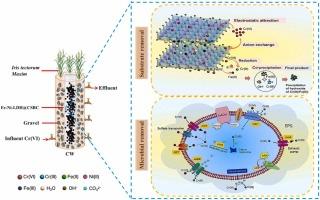Enhanced removal of Cr (VI) in constructed wetland with Fe-Ni-LDH-modified crayfish shell biochar: Performance, removal pathways and synergy mechanisms of substrate-microorganism
IF 11.3
1区 环境科学与生态学
Q1 ENGINEERING, ENVIRONMENTAL
引用次数: 0
Abstract
In this study, Fe-Ni-layered double hydroxide modified crayfish shell biochar substrate (Fe-Ni-LDH@CSBC) was successfully prepared and introduced into constructed wetland (CW) to research the Cr(VI) removal mechanism through substrate adsorption and microbial action. Adsorption experiments demonstrated the equilibrium adsorption capacities of Fe-Ni-LDH@CSBC for Cr(VI) could reach 1058.48 (C0=10 mg/L) and 1394.59 mg/kg (C0=20 mg/L). The CW with Fe-Ni-LDH@CSBC showed higher removal efficiencies of COD, TN, TP, and Cr(VI), which respectively reached 72.9%, 66.8%, 79.6%, and 99.3% with influent Cr(VI) concentration of 50 mg/L. The Fe-Ni-LDH@CSBC stimulated the secretion of extracellular polymeric substances (EPS) (570.6 mg/g VSS), conducive to absorbing Cr(VI) and also delaying or preventing Cr(VI) from entering microorganisms. The increased reduction of Cr(VI) by Fe-Ni-LDH@CSBC was due to its role in enhancing extracellular electron transfer (EET) through boosting cytochrome c and NADH levels. Metagenomic sequencing showed that Fe-Ni-LDH@CSBC increased the abundances of resistant microorganisms (Mycobacterium, Mycolicibacterium, and Hyphomicrobium) in CW, and the relative abundance of key functional genes from Cr(VI) reductase (chrR, GST, czcD, zitB, and merR), electron transfer genes (mtrC, fbpC, insB, and afuC) and transport proteins genes (rhtC, pcoB, bpeT, pecM, chrA, and exbB). This research presented an effective method to enhance the removal of Cr(VI) from electroplating wastewater using CW with Fe-Ni-LDH@CSBC.

fe - ni - ldh修饰的小龙虾壳生物炭对人工湿地中Cr (VI)的去除效果、去除途径及协同作用机制
本研究成功制备了fe - ni层状双氢氧化物修饰的小龙虾壳生物炭底物(Fe-Ni-LDH@CSBC),并将其引入人工湿地(CW)中,研究了底物吸附和微生物作用对Cr(VI)的去除机理。吸附实验表明Fe-Ni-LDH@CSBC对Cr(VI)的平衡吸附容量分别为1058.48 (C0=10 mg/L)和1394.59 mg/kg (C0=20 mg/L)。当进水Cr(VI)浓度为50 mg/L时,Fe-Ni-LDH@CSBC对COD、TN、TP和Cr(VI)的去除率分别达到72.9%、66.8%、79.6%和99.3%。Fe-Ni-LDH@CSBC刺激胞外聚合物质(EPS)的分泌(570.6 mg/g VSS),有利于吸收Cr(VI),也可以延缓或阻止Cr(VI)进入微生物。通过Fe-Ni-LDH@CSBC增加Cr(VI)的还原是由于其通过提高细胞色素c和NADH水平来增强细胞外电子转移(EET)的作用。宏基因组测序结果显示,Fe-Ni-LDH@CSBC增加了CW中耐药微生物(分枝杆菌、分枝杆菌和菌丝菌)的丰度,并增加了Cr(VI)还原酶(chrR、GST、czcD、zitB和merR)、电子转移基因(mtrC、fbpC、insB和afuC)和转运蛋白基因(rhtC、pcoB、bpeT、pecM、chrA和exbB)的相对丰度。本研究提出了一种利用Fe-Ni-LDH@CSBC连续水处理提高电镀废水中Cr(VI)去除率的有效方法。
本文章由计算机程序翻译,如有差异,请以英文原文为准。
求助全文
约1分钟内获得全文
求助全文
来源期刊

Journal of Hazardous Materials
工程技术-工程:环境
CiteScore
25.40
自引率
5.90%
发文量
3059
审稿时长
58 days
期刊介绍:
The Journal of Hazardous Materials serves as a global platform for promoting cutting-edge research in the field of Environmental Science and Engineering. Our publication features a wide range of articles, including full-length research papers, review articles, and perspectives, with the aim of enhancing our understanding of the dangers and risks associated with various materials concerning public health and the environment. It is important to note that the term "environmental contaminants" refers specifically to substances that pose hazardous effects through contamination, while excluding those that do not have such impacts on the environment or human health. Moreover, we emphasize the distinction between wastes and hazardous materials in order to provide further clarity on the scope of the journal. We have a keen interest in exploring specific compounds and microbial agents that have adverse effects on the environment.
 求助内容:
求助内容: 应助结果提醒方式:
应助结果提醒方式:


